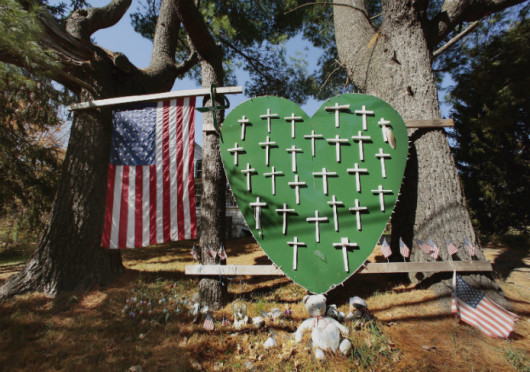
On Oct. 21, there are still signs around town of the grief felt after the shooting Dec. 14, 2012, in Newtown, Conn.
Credit: Courtesy of MCT
RIDGEFIELD, Conn. – Saturday came and went with small, meaningful remembrances of what happened one year before, about 25 minutes away from where my family lives. It was exactly the kind of memorial day that was called for.
A Dec. 14, 2012, shooting at Sandy Hook Elementary School in Newtown, Conn., resulted in the deaths of 26, 20 of whom were children ages 6 and 7. The gunman also killed himself at the scene.
Newtown did not have any big memorial events planned Saturday. Bells were rung 26 times across Connecticut at about the time the gunman had entered the school, 9:30 a.m., and flags were lowered to half-staff at Gov. Dannel Malloy’s request.
Besides that, the stories I saw shared online Saturday and in the weeks leading up to it about remembering the day were mostly about the innocent lives lost and about a small-town community coming together (and at times, coming apart) after a tragedy. People weren’t sharing the articles attempting to explain the reasoning of the man who committed the crimes anymore.
And we should all be thankful they weren’t.
Since that day last December, there have been dozens of U.S. mass killings, which are defined as the killings of at least four people, according to the FBI. Not all of these incidents made national news, and it’s better they didn’t.
Recent findings have suggested the frequency that mass killings are reported on and the way they’re treated in the news can cause a domino effect that leads to more similar incidents.
The same thing has been shown in the past to happen with suicides: the more attention the press gives the incidents, the more they occur.
By taking the focus off of the person committing the act and instead shining a light on those who died, news outlets might be able to help diminish the number of attacks. Those who aren’t involved in the news, however, can help, too, by not clicking on sensationalist headlines or encouraging the publication of far-reaching stories.
After all, the job of reporters is largely to tell the truth and serve our audiences.
While people across America were riveted by tapes of the Sandy Hook 911 calls and captivated by reports of what could be to blame for the shooting, it might not be best serving the audience to publish such lurid or dramatic content. Even worse, people could be put at risk of later losing their loved ones because of that never-ending coverage.
The world is full of stories about death, sickness and some people’s warped sense of what is right and wrong. But while these mass killings are still frequently happening, reporters are obligated to lay our pens down, turn off our recorders and take a second before writing to close our eyes and imagine the guilt that would fall upon our shoulders if another day like Dec. 14, 2012, happened. By avoiding sensationalism in our reporting, we can help diminish the likelihood that it will.
More than that, though, people everywhere need to start exercising a similar restraint. As much as we as nosy humans might feel like we need to hear the terrifying details of these events that can occasionally feel like a horror movie, this is real life and it won’t stop until we stop.
It won’t slow down until the “share” button isn’t clicked on stories about who the man behind the gun was, or until those kinds of stories aren’t even written.
Our pressing desire to know it all isn’t worth another Newtown.


